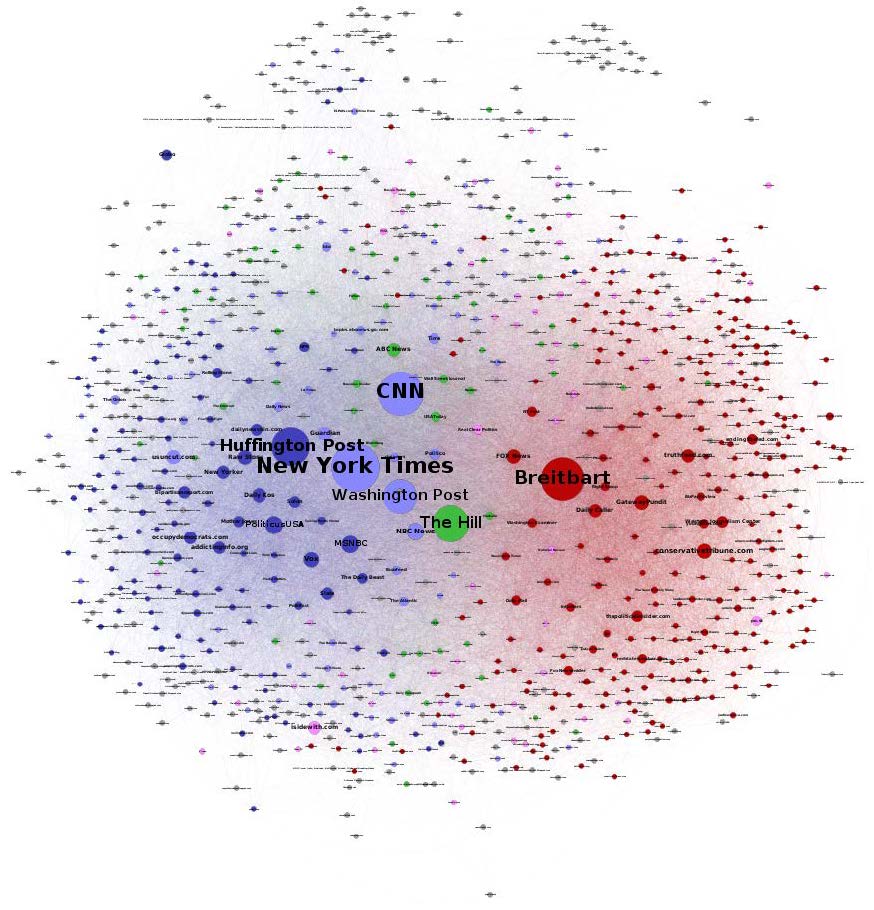The Berkman Klein Center for Internet & Society at Harvard University has released a comprehensive analysis of online media and social media coverage of the 2016 presidential campaign. The report, “Partisanship, Propaganda, and Disinformation: Online Media and the 2016 U.S. Presidential Election,” documents how highly partisan right-wing sources helped shape mainstream press coverage and seize the public’s attention in the 18-month period leading up to the election.
“In this study, we document polarization in the media ecosystem that is distinctly asymmetric. Whereas the left half of our spectrum is filled with many media sources from center to left, the right half of the spectrum has a substantial gap between center and right. The core of attention from the center-right to the left is large mainstream media organizations of the center-left. The right-wing media sphere skews to the far right and is dominated by highly partisan news organizations,” co-author and principal investigator Yochai Benkler stated. In addition to Benkler, the report was authored by Robert Faris, Hal Roberts, Bruce Etling, Nikki Bourassa, and Ethan Zuckerman.
The fact that media coverage has become more polarized in general is not new, but the extent to which right-wing sites have become partisan is striking, the report says.
The study found that on the conservative side, more attention was paid to pro-Trump, highly partisan media outlets. On the liberal side, by contrast, the center of gravity was made up largely of long-standing media organizations. Robert Faris, the Berkman Klein Center’s research director, noted, “Consistent with concerns over echo chambers and filter bubbles, social media users on the left and the right rarely share material from outside their respective spheres, except where they find coverage that is favorable to their choice of candidate. A key difference between the right and left is that Trump supporters found substantial coverage favorable to their side in left and center-left media, particularly coverage critical of Clinton. In contrast, the messaging from right-wing media was consistently pro-Trump.” Conservative opposition to Trump was strongest in the center-right, the portion of the political spectrum that wielded the least influence in media coverage of the election.
In this recently-emerged universe, Breitbart stands at the center of a right-wing media ecosystem and is surrounded by sites like Fox News, the Daily Caller, the Gateway Pundit, the Washington Examiner, Infowars, Conservative Treehouse, and Truthfeed, according to the report’s analysis.
The report finds that political clickbait sites—hyperpartisan sites that frequently engage in dubious reporting—exist on both sides of the political spectrum, but these sites played a larger role on the right than the left. On the more insular and partisan right, the “fake news,” or political clickbait sites were a more integral part of the media sphere. On the left, readers gravitated towards center-left large media organizations which moderated the impact of political clickbait on the left.

This overall trend and the quantitative differences in coverage were far more consequential than the circulation of outright false stories, the analysis found. “Although fake news–fabricated and verifiably false reporting–was a phenomenon during the election, it had a minor effect on the media ecosystem of the presidential election according to our findings. A much larger concern was the misleading reporting that was propagated through partisan networks,” co-author and Media Cloud technical lead Hal Roberts stated.
The report found that the majority of mainstream media coverage was negative for both candidates, but largely followed Trump’s agenda. Immigration received more attention than any other substantive issue. However, it was eclipsed by the attention given to the scandals surrounding Hillary Clinton’s use of a private email server and the Clinton Foundation, which were perpetuated through the release of hacked emails. These two topics, immigration and emails, defined the public narrative around the choices for voters in the 2016 election.
The Berkman Klein study is based on an analysis of more than 2 million stories related to the election published online by approximately 70,000 media sources, between May 1, 2015, and Election Day in 2016, as well as an analysis of how often sources were linked to by other online sources and how often they were shared on Facebook or Twitter.
The study analyzed:
- Cross-linking patterns between media sources to offer a view of authority and prominence within the media world.
- Sharing of media sources by users on Twitter and Facebook, which provides a broader perspective on the role and influence of media sources among people engaged in politics through Twitter and Facebook.
- The differential media sharing patterns of Trump and Clinton supporters on Twitter, which enables a detailed analysis of the role of partisanship in the formation and function of media structures.
- Content analysis using automated tools to support the tracking of topics over time among media sources.
- Qualitative media analysis of individual case studies to enhance our understanding of media function and structure.
The research used Media Cloud, an open-source dataset and suite of analysis tools jointly run by the Berkman Klein Center and MIT’s Center for Civic Media. An earlier version of the research appeared as a report in March in Columbia Journalism Review.
For more on the report and on the Media Cloud platform, visit the Berkman Klein Center website.
Related Coverage
“Down the Breitbart Hole” (The New York Times Magazine online, August 16, 2017)
“Researchers Examine Breitbart’s Influence on Election Information” (NPR’s Morning Edition, March 14, 2017)
A study of 1.25 million media stories says a Breitbart-centered media ecosystem fostered the sharing of stories that were, at their core, misleading. Steve Inskeep talks to researcher Yochai Benkler.
“The great divide: Trump and the press” (CBS Sunday Morning, June 18, 2017)
Senior CBS News contributor Ted Koppel talks with commentator Pat Buchanan and Harvard professor Yochai Benkler about the battle between presidents and the press, what news Americans are choosing to consume, “fake” news, and the media war for hearts and minds.
